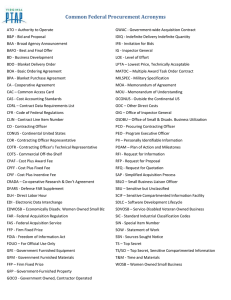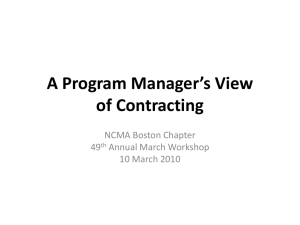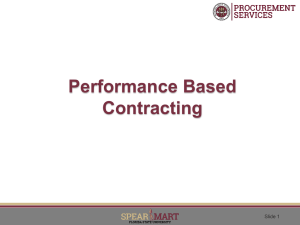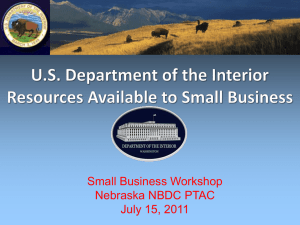Document 10283630
advertisement
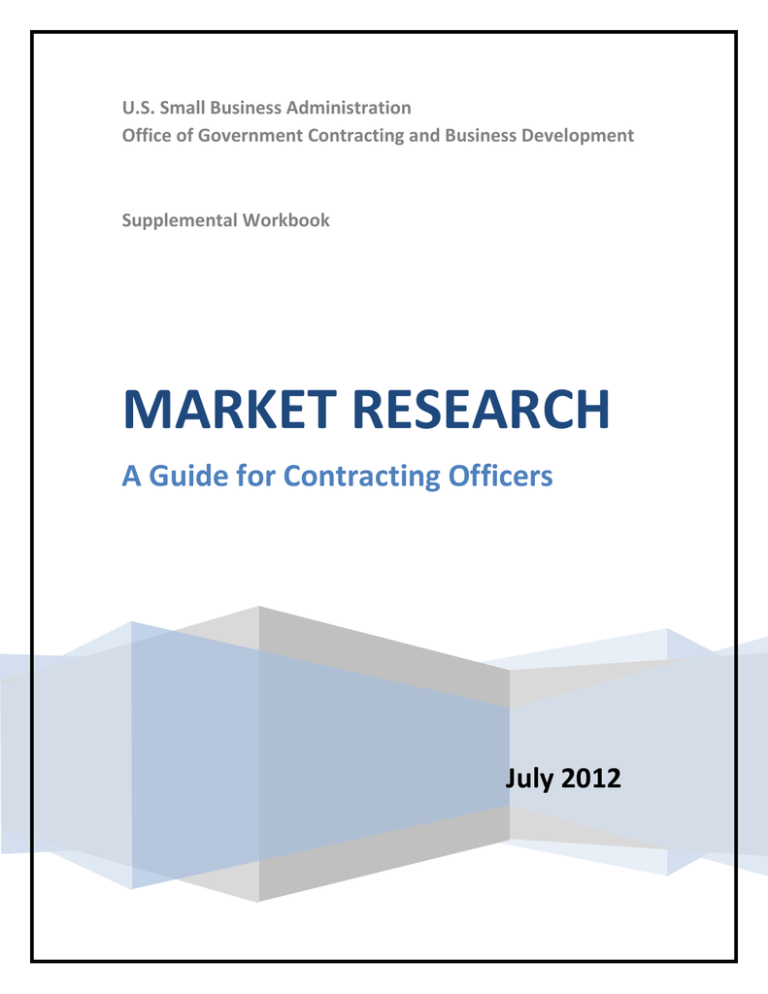
U.S. Small Business Administration Office of Government Contracting and Business Development Supplemental Workbook MARKET RESEARCH A Guide for Contracting Officers July 2012 “Market Research” A Guide for Contracting Officers Office of Government Contracting & Business Development Market Research July 2012 Welcome to SBA’s guide about market research -- for contracting officers. Although this training program is designed for contracting officers, we believe that all federal agency and buying office personnel associated with the procurement process will find it useful. NOTE: This supplemental workbook tracks the slides and narrative Page 2 contained in the online training program, “Market Research” – A Guide for Contracting Officers. The online version of the training program, with audio can be accessed at: www.sba.gov/gcclassroom. For the user’s convenience, all hyperlinks contained in the copied slides are included as links at the end of the workbook. Introduction This training module is about market research. Specifically, understanding and using market research to find qualified small business vendors. Page 3 Notes: Introduction (cont) • • • Understand and apply market research to arrive at the most suitable acquisition approach FASA and FARA brought increased attention to market research Use of market research to find qualified small business vendors Learn more… FAR 10.000-10.003 -- Market Research -- Market research is a common business practice used by government buyers and commercial firms. With the passage of the Federal Acquisition Streamlining Act of 1994 (FASA) and the Federal Acquisition Reform Act of 1996 (FARA), Congress dramatically shifted procurement policy for the federal government. Central to the reforms are the mandates to maximize the acquisition of commercial items and services, and to acquire those items in a manner similar to that used by the commercial business sector. Two of the biggest changes brought by FASA and FARA are the significant discretion allowed to the contracting officer in acquiring commercial items and the increased attention to market research as an integral part of the procurement process. Implicit in these important changes is the use of market research to find suitable small business vendors. Page 4 Notes: Multiple topics are discussed in this guide and they are indexed, such that any specific topic, at any time can be easily accessed. Page 5 Notes: Market Research Page 6 Notes: Regulatory Perspective Federal Acquisition Streamlining Act – Title 10 U.S. Code, Sec.2377 FAR 10.000 – 10.003 -- Market Research FAR 2.101 – Market Research Definition FAR 7.102 – Acquisition Planning and Market Research FAR 19.202 – Small Business Policy -- Market Research -- The Federal Acquisition Streamlining Act of 1994 set a new tone and emphasized the use of market research by federal agencies. The government’s rules and policies regarding market research are defined primarily in FAR Part 10, FAR Part 2.101 and FAR Part 7.102. In addition, the federal government’s policy on small business utilization and the requirements for contracting officers to locate and encourage the maximum participation of small businesses is outlined in FAR Part 19, specifically FAR Part 19.202. In addition, multiple agencies have published FAR Supplements to define specific polices on the use of market research. Also, many agencies and buying offices have developed “Best Practices” guides which include assistance regarding effective market research techniques. It is helpful and important to become aware of available best practices. You may also consider recording and making available best practices for your own agency or buying unit. Page 7 Notes: Market Research – Defined • Continuous process of collecting and analyzing data on products, services, business practices and vendor capabilities • Critical tool in helping contracting officers to find qualified small business vendors -- Market Research -- So… what is market research? Market research is the continuous process of collecting and analyzing data on products, services, business practices and vendor capabilities to satisfy agency needs. Simply put, market research is learning about the market to make informed and suitable decisions and choices about the acquisition of goods and services. Market research is also a critical tool in helping contracting officers find qualified small business vendors. Simply stated, market research is the foundation for building an effective solicitation and a successful contract. It is the most important methodology a contracting officer can use to find small business vendors. And, small businesses are critically important to promoting competition in the procurement process and growing the overall economy. Page 8 Notes: Value of Small Firms • • • • Small businesses are the engine for economic growth in America Provide jobs, innovation and competition Government policy provides “maximum practicable” prime and subcontract opportunities to small firms Government’s small business policy can best be fulfilled with solid market research -- Market Research -- Small businesses provide jobs, innovation and bring competition to the marketplace. There are more than 27 million small businesses in the United States and they employ about half of all U.S. workers. Importantly, small firms are the largest creator of net new jobs in America. The Government’s procurement policy – which encourages “maximum practicable” prime and subcontract opportunities for small businesses – is a catalyst for economic growth. This policy – which is defined in both statute and federal regulations – can best be fulfilled with solid market research. Page 9 Notes: Small Business Federal Policy • • • Collecting and analyzing market information about small business capabilities to satisfy agency needs Government-wide small business goals Market research is often used to document compliance with small business requirements Learn more… FAR 19.202; FAR 2.101 -- Market Research -- A contracting officer is required to encourage maximum participation by small businesses in agency acquisitions. Before a solicitation is issued, a contracting officer should make every reasonable effort to find qualified small business vendors. This is market research – that is collecting and analyzing information about small business capabilities within the market to find qualified firms and satisfy agency needs. It is also referred to as market intelligence. Market research is also an effective tool to help agencies or buying units to meet overall small business goals or subcategory goals such as SDB, HUBZone WOSB and/or service disabled veteran owned small business goals. In addition, market research is often used to document compliance with small business requirements. This is important. Page 10 Notes: Market Research is Required • • • Market research is critical to elevating small business participation – should be ongoing Required – FAR 10.001 (a) (2) Must be conducted: – before developing new contract requirement documents – before soliciting offers for acquisitions above the simplified acquisition threshold – before soliciting offers for requirements below the simplified acquisition threshold, when sufficient information about small firms is not available – before soliciting offers that could lead to contract bundling and consolidation Learn more… FAR 10.001 (a)(2) -- Market Research -- Market research is critical to elevating the participation of small businesses in the federal contracting space. It is a form of practical education that is more than just a process – it should be meaningful, continuous and ongoing. FAR 10.001(a)(2) – requires that market research be conducted, as appropriate to specific buying circumstances. Specifically, before developing new contract requirement documents; before soliciting offers for acquisitions above the simplified acquisition threshold; before soliciting offers for requirements below the simplified acquisition threshold, when sufficient information about small firms is not available; and, before soliciting offers that could lead to contract bundling and consolidation. It is also important to note, Federal Supply Schedule acquisitions, as highlighted in FAR Part 8.4, are not exempt from market research and the development of acquisition plans. Page 11 Notes: GAO Case & Market Research • • GAO case B-406256 demonstrates the importance for agencies to conduct sufficient market research Agency’s decision was reversed for “taking insufficient efforts to ascertain small business capability” -- Market Research -- Market research is important, especially with regards to the consideration of small firms. The recent GAO case – B-406256 – clearly highlights this. In this case, the agency’s decision was reversed for taking “insufficient efforts to ascertain small business capability.” Page 12 Notes: Purpose of Market Research • Performed to support the development of effective acquisition planning • • Objective is to arrive at the most suitable acquisition approach Should provide solid information on: – Requires written acquisition plan – – – – – – Existing products Capable small business sources Competitive market forces Commercial practices Product performance and quality Successful acquisition practices of other organizations Learn more… FAR 7.102; FAR 7.105 -- Market Research -- Market research should be performed to support the development of an effective acquisition plan. FAR Part 7.102 requires acquisition planning and market research for all acquisitions. FAR Part 7.105 requires that written acquisition plans document how the information obtained through market research was used in developing elements of the plan. The ultimate objective of market research is to arrive at the most suitable approach to acquiring, distributing and supporting supplies and services. A well executed market research process will provide solid information on: existing products, capable small business sources, competitive market forces, commercial practices, varying levels of product performance and quality and successful acquisition practices of other organizations. Page 13 Notes: Use of Market Research • • • Determine availability of small business sources Determine if commercial items are available Determine if contract bundling and consolidation are avoidable or justified Learn more… FAR 19.202-2 -- Market Research -- A key goal of market research is to determine and find qualified small business sources. It is also used to determine if commercial items are available to meet acquisition requirements. In addition, market research is used to evaluate circumstances surrounding the possible consolidation of contract requirements and to determine if contract bundling and consolidation are avoidable. Page 14 Notes: Market Research Documentation • • • • • • • Explanation of the acquisition’s background and purpose Description of the agency’s needs, in terms of function and performance Desired schedule of delivery List of small business and other sources who were contacted Discussion of customary commercial practices Identification of price ranges discovered Description of available commercial or non-developmental items -- Market Research -- While agencies must document the results of market research, “in a manner appropriate to the size and complexity of the acquisition,” there is no specific format that must be used. The report should summarize the activities of those conducting the market research. At a minimum, the following items should be included in the documentation: explanation of the acquisition’s background and purpose; description of the agency’s minimum needs, in terms of function and performance; desired schedule of delivery; list of small business and other sources who were contacted, including the methodology used for compiling and refining the list of potential vendors; discussion of customary commercial practices; identification of price ranges discovered; and a description of available commercial or non-developmental items. If the resulting procurement strategy does not include small firms, market research documentation should explicitly explain why a set-aside is not appropriate, as well as the specific steps that will be taken to mitigate a negative impact on small businesses. Page 15 Notes: Market Research = Market Intelligence -- Market Research -- Market research is evolving into market intelligence. That is, a solid understanding of the industry and market through investigation & discovery, surveys, requests for information, trade events, associations, site visits, “industry days,” etc. Solid market research or market intelligence can be used to: validate requirements, or not; identify more efficient requirements – to eliminate gold-plating; ensure that requirements are consistent with industry practices; and, importantly, ensure that requirements are inclusive of small business. Page 16 Notes: Resources for Market Research Page 17 Notes: Resources for Market Research • • • Historical records – recent research, former bidder lists, current awardees, etc. Knowledgeable contract professionals (PCRs, BOSs, etc.) Industry conferences, publications, meetings and databases -- Market Research -- Market research is not an exact science, but many excellent resources are available to assist in such efforts. It is helpful to begin with historical files for similar acquisitions. Review recent market research, former bidder lists, current awardees and other related information. In addition, contact knowledgeable small business contract professionals, such as PCRs, Business Opportunity Specialists, PTAC employees and small business specialists, within and outside of your agency. Also, industry conferences, publications and meetings can be a great resource for market research. When considering the use of the 8(a) Business Development Program to meet your needs, an SBA, district office, Business Opportunity Specialist can be an invaluable resource in identifying capable program participant firms. And, finally use market research databases. This is critically important and easy to do. Page 18 Notes: Databases & Other Resources • Central Contractor Registration (CCR) – (soon to become the System for Award Management [SAM]) • Dynamic Small Business Search (DSBS) • Federal Business Opportunities • Federal Procurement Data System • GSA Federal Supply Schedule (find similar item vendors) • Interagency Contract Directory • Veterans – Vendor Information Pages • Thomas-Net (industry connection) • Commercial search engines – – – – – – – – – http://www.ccr.gov or http://sam.gov http://www.ccr.gov click on DSBS http://www.fedbizopps.gov http://www.fpds.gov http://www.gsaelibrary.gsa.gov http://www.contractdirectory.gov http://www.vetbiz.gov http://www.thomasnet.com http://www.google.com (or similar) -- Market Research -- There are numerous government-sponsored databases that can assist in market research efforts. Such systems include, the CCR, which will soon become part of the System for Award Management or SAM; the Dynamic Small Business Search; FedBizOpps; the Federal Procurement Data System; GSA’s Federal Supply Schedule – to identify vendors that already perform work similar to your needs, the Interagency Contract Directory, The Veterans – Vendor Information Pages, Thomas-Net, and don’t forget commercial search engines. They are an incredible resource. And finally, feel free to call one of SBA’s PCRs or small business specialists to help in your research. Page 19 Notes: Locating Qualified Small Businesses Page 20 Notes: Locating Qualified Small Businesses • • • Dynamic Small Business Search (DSBS) Issue “Sources Sought Notice” “Industry Days” and Matchmaker events -- Market Research -- There are three primary ways to find qualified small business vendors. First and primary, use the dynamic small business search function within the CCR or SAM, and second, issue a “sources sought notice” online, in Fedbizopps, the Federal Register or through agency electronic bulletin boards. And finally, participate in industry and matchmaker events. Page 21 Notes: Dynamic Small Business Search • • • • CCR/SAM and DSBS are part of the Integrated Acquisition Environment (IAE) Searchable database of small businesses in all socioeconomic categories Identifies SBA certifications for 8(a) and HUBZone certified firms Used also by prime contractors to locate teaming partners or subcontractors -- Market Research -- The Dynamic Small Business Search function is incorporated into the CCR or the new SAM system. It is a searchable database that is the most widely used and the most proficient in identifying small business vendors. Its limitations, of course are tied to the availability and accuracy of data input by small firms and the quality of searches conducted by users. The tool has many functions including the identification of SBA 8(a) and HUBZone certified firms, WOSBs, service disable veteran owned small firms, and/or other small businesses. The DSBS is also used by prime contractors to locate partners or subcontractors. It is by far one of the best tools available, both for small businesses and agency or prime buyers. With that said, it is important for contracting officers to remind prospective small business vendors that their SAM / DSBS profiles are living files and should be updated at least every six to twelve months. A SAM or CCR profile is like a resume. It should be current, accurate and very clear, especially with regards to qualifications. Specifically, NAICS codes, key words and skill or experience descriptors should be current, inclusive and very clear. Page 22 Dynamic Small Business Search – is a great tool to assess the capabilities and capacity within the various small business subcategories and can be invaluable to your efforts in identifying capable firms, particularly if an office needs to increase opportunities for a particular subcategory to meet its goals. Tips for DSBS • • • Prepare for your search Scale your search and be flexible Document searches for your Market Research Report -- Market Research -- The Dynamic Small Business Search system is a powerful tool, but its effectiveness is closely aligned with the thoughtfulness of your search. That is -- be diligent about preparing for your search. Make a list of your search criteria, such as specific capability key words and NAICS codes you plan to use – well before you engage the DSBS system. Scale your search and be flexible. The search net you cast should be expanded or limited based on findings and need. It is not necessary that you complete every available search field. The more fields you use, the more narrow your search will be. Importantly, document all search criteria used as well as the results of each search to include in your market research report. Page 23 Notes: Issue Sources Sought Notices • • • May be appropriate for a wide range of planned acquisitions Published in FedBizOpps (FBO), Federal Register or electronic bulletin boards Can provide excellent documentation to support a chosen procurement strategy -- Market Research -- Issuing a “Sources Sought Notice” can be an excellent way to find available, willing and capable small businesses vendors, especially, 8(a) and HUBZone firms, service disable veteran owned small businesses, women owned small businesses, and economically disadvantaged women owned small businesses. This approach may be appropriate for a wide range of acquisitions that are planned. Publishing such notices may take a little more time but can be very effective in attracting potential small business contractors. Sources Sought Notices can be published online, in FedBizOpps, the Federal Register or in other locations. The results from a Sources Sought Notice can provide solid documentation to support a chosen procurement strategy. However, to be truly effective, it’s important that evaluations of responses to sources sought notices be genuine and not “gamed” to exclude small business results. Page 24 Notes: Industry Days and Matchmaker Events • • Participate in “Industry Days” and matchmaker events Excellent way to identify capable small business sources -- Market Research -- Participation by agency personnel, specifically technical and requirements development staff – in industry sponsored events and matchmaker events can be essential in identifying capable small business sources for both current and future requirements. Page 25 Notes: Resources and Questions Page 26 Notes: Resources and Tools • Federal Acquisition Regulations • Acquisition Central • FAR Part 19 – Small Business Programs – – – https://www.acquisition.gov/far https://www.acquisition.gov/ http://www.acquisition.gov/far • Code of Federal Regulations (13CFR) • Federal Business Opportunities • SBA-Government Contracting – – – http://www.gpoaccess.gov/cfr/index.html http://www.fbo.gov http://www.sba.gov/aboutsba/sbaprograms/gc/index.html -- Market Research -- Numerous resources are available to assist contracting officers and other contracting personnel with market research and general contracting issues or questions. Page 27 Notes: Resources and Tools • Learn more about: – – – – – • Non-manufacturer waivers (SBA information) SBA Size Standards 8(a) Business Development Program WOSB Program HUB Zone Program Local (client) resources: – – – – SBA district office (Business Opportunity Specialists) Procurement Technical Assistance Center (PTAC) SCORE chapter Small Business Development Center – Women’s Business Center • • SBA/SBDC Program Office SBA/WBC Program -- Market Research -- Use these resources to enhance your procurement strategy. Page 28 Notes: Contact Us… • • Thank you for taking the time to learn about “Market Research” Please contact us with any questions you may have U.S. Small Business Administration Office of Government Contracting and Business Development 800 827-5722 -- Market Research -- Thank you for taking the time to learn about market research. Market research is the responsibility of all involved in the procurement and requirements development process. A strong and efficient procurement process – which maximizes small business participation – is only possible if all involved in the process embrace the concept of solid acquisition planning and market research. Much information has been discussed and we hope it is helpful. Please contact us with any additional questions you may have. Thank you. Page 29 Notes: Hyperlinks Contained in the Workbook Central Contractor Registration (CCR) – (soon to become the System for Award Management [SAM]) – Dynamic Small Business Search (DSBS) – • Federal Business Opportunities – • https://www.acquisition.gov/far Acquisition Central – • http://www.google.com (or similar) Federal Acquisition Regulations – • http://www.thomasnet.com Commercial search engines – • http://www.vetbiz.gov Thomas-Net (industry connection) – • http://www.contractdirectory.gov Veterans – Vendor Information Pages – • http://www.gsaelibrary.gsa.gov Interagency Contract Directory – • http://www.fpds.gov GSA Federal Supply Schedule (find similar item vendors) – • http://www.fedbizopps.gov Federal Procurement Data System – • http://www.ccr.gov click on DSBS https://www.acquisition.gov/ FAR Part 19 – Small Business Programs 30 • http://www.ccr.gov or http://sam.gov Page • – Code of Federal Regulations (13CFR) – Federal Business Opportunities – • SBA-Government Contracting – • • http://www.fbo.gov http://www.sba.gov/aboutsba/sbaprograms/gc/index.html Learn more about: – SBA Size Standards – 8(a) Business Development Program – WOSB Program – HUB Zone Program Local (client) resources: – SBA district office – Procurement Technical Assistance Center (PTAC) – SCORE chapter – Small Business Development Center • – SBA/SBDC Program Office Women’s Business Center • SBA/WBC Program 31 • http://www.gpoaccess.gov/cfr/index.html Page • http://www.acquisition.gov/far

